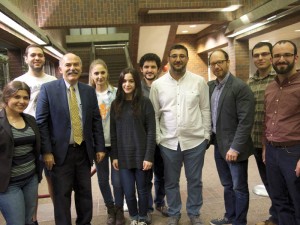Michael Rettig
Staff Writer

Photo: Hourig Attarian
One important narrative of the Armenian Genocide that has been neglected is the story of the righteous Turks who risked their lives to save Armenians. It reminds us that animosity towards Armenians was not universal among Turks in the Ottoman Empire and that there were those who would defy the law to protect Armenians. This narrative is not only important for the Armenians to remember, but for the Turks as well. It is the story of these righteous Turks, who the Turks of today must hold as the standard bearers of humanity in a dark time in their history.
Ümit Kurt, a doctoral candidate at Clark University and Kazan Visiting Scholar at Fresno State, has been documenting the stories of righteous Turks with his supervisor, Dr. Taner Akçam. On Friday, November 6, Kurt presented his findings in a lecture, “Righteous Turks: Two Turkish Officials Who Saved the Lives of Armenians.” This lecture was part of the Armenian Sturdies Program’s Fall Lecture Series with the support of the Leon S. Peters Foundation.
Kurt opened his lecture by stating that there were many Turks and Kurds who saved Armenians. “Despite the order of the Committee of Union and Progress party, which stipulated that anyone who protects and hides Armenians will be executed, these Muslims continued to hide and protect Armenians by challenging this official order.” For his presentation, Kurt chose to focus on two state officials, Cemil Kunneh and Ahmed Necmettin Bey, who used their positions to protect Armenians.
Cemil Kunneh, who Kurt referred to as a “Kurdish Schindler,” was a lieutenant in the Ottoman Marine army and was assigned to direct the Birecik shipyard, where boats were made to ferry Ottoman soldiers across the Euphrates River. During the Genocide, Kunneh recruited Aintab’s Protestant Armenians to work in the shipyard.
“In doing so, Kunneh managed to save Aintab Armenians from perishing in Der Zor. Kunneh constructed tents for the Armenian workers and their families as well as providing them with clothes, food, and medicine,” stated Kurt, who then told the story of Hagop Mouradian who was one of the Armenians that Kunneh saved from deportation.
Mouradian was a well-educated Armenian who became a photographer and opened his own studio. While Mouradian was on the deportation route to Der Zor, he was hired by Kunneh in Birecik, thus sparing his life.
After the British occupation of Istanbul and the war trials that followed in 1919, Armenians who were saved by Kunneh drafted a joint letter of thanks for his efforts to save their people. “This letter was probably written by Armenians to protect Kunneh from being put on trial by the Allied Powers,” said Kurt.
Kurt’s second example of a “righteous Turk,” was Ahmed Necmettin Bey, a conscientious Turk who was opposed to the CUP from the beginning. He was the district governor of Aintab until he was moved to Salamia, where he became the Kaimakan.
His story is particularly interesting because his opposition to the CUP in 1908 incited an Armenian and Muslim mob to beat him.
Even after the beating, according to Kurt, Necmettin Bey did not follow the extermination policy of the CUP party against Armenians and did not condemn all Armenians. Krikor Bogharian, an Armenian who was saved by Necmettin Bey, described him as “favorable towards Armenians” in his diary.
Necmettin Bey saved Armenians in a similar fashion to that of Cemil Kunneh. He hired Armenian artisans and their families who were to be deported from Aintab and brought them to Salamia. “He tried to save Armenians from deportation by hiring them in his construction projects,” said Kurt.
“If we would like to judge history justly, we should not forget his deeds and his virtuous acts. We shall give him his due,” said Genocide survivor Bogharian. Necmettin Bey was eventually dismissed and relocated due to his activities.
“In Ahmed Necmettin Bey, we encounter a conscientious Turk who disobeyed the orders of Talaat Pasha and used the authority of his position in order to save Armenians rather than annihilate them,” asserted Kurt.
It is important for the stories of conscientious Turks such as Cemil Kunneh and Ahmed Necmettin Bey to be studied and remembered. They are examples of individuals who were able to hold onto their humanity in a time of genocide and brutality.
 Hye Sharzhoom Armenian Action
Hye Sharzhoom Armenian Action